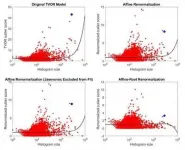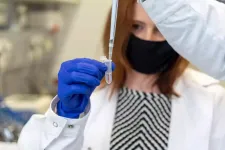(Press-News.org) A process that uses heat to change the arrangement of molecular rings on a chemical chain creates 3D-printable gels with a variety of functional properties, according to a Dartmouth study.
The researchers describe the new process as "kinetic trapping." Molecular stoppers--or speed bumps--regulate the number of rings going onto a polymer chain and also control ring distributions. When the rings are bunched up, they store kinetic energy that can be released, much like when a compressed spring is released.
Researchers in the Ke Functional Materials Group use heat to change the distribution of rings and then use moisture to activate different shapes of the printed object.
The process of printing objects with different mechanical strengths using a single ink could replace the costly and time-consuming need to use several inks to print items with multiple properties.
"This new method uses heat to produce and control 3D inks with varieties of properties," said Chenfeng Ke, an assistant professor of chemistry and the senior researcher on the study. "It's a process that could make the 3D printing of complex objects easier and less expensive."
Most common 3D printing inks feature uniform molecular compositions that result in printed objects with a single property, such as one desired stiffness or elasticity. Printing an object with multiple properties requires the energy-intensive and time-consuming process of preparing different inks that are engineered to work together.
By introducing a molecular "speed bump," the researchers created an ink that changes the distribution of molecular rings over time. The uneven rings also transform the material from a powder into a 3D printing gel.
"This method allowed us to use temperature to create complex shapes and make them acuate at different moisture levels," said Qianming Lin, a graduate student researcher at Dartmouth and first author of the study.
A video demonstrating the research shows a flower printed using a 3D ink produced with the process. The flower closes when exposed to moisture. Different parts of the printed flower have different levels of flexibility created by the arrangement of molecular rings. The mixture of properties allows the soft petals to close while the firmer parts of the flower provide structure.
Printing the same flower using current 3D printing methods would come with the extra challenge of combining different printed materials.
"The different parts of this object come from the same printing ink," said Ke. "They have similar chemical compositions but different numbers of molecular rings and distributions. These differences give the product drastically different mechanical strengths and cause them to respond to moisture differently."
The study, published in Chem, accesses the energy-holding "meta-stable" states of molecular structures made of cyclodextrin and polyethylene glycol--substances commonly used as food additives and stool softeners. By installing the speed bumps on the polyethylene glycol, the 3D-printed objects become actuators that respond to moisture to change shape.
According to the research team, future efforts to refine the molecule will allow precision control of multiple meta-stable states, allowing for the printing of "fast-responsive actuators" and soft robots using sustainable energy sources, such as variation in humidity.
The resulting printed objects could be used for medical devices or in industrial processes.
INFORMATION:
Longyu Li, a former research associate in the Ke Functional Materials Group, Jayanta Samanta, a research associate, graduate students Miao Tang and Lingyi Zou, and Shangda Li also contributed to this research.
DURHAM, N.C. - Combining structural biology and computation, a Duke-led team of researchers has identified how multiple mutations on the SARS-CoV-2 spike protein independently create variants that are more transmissible and potentially resistant to antibodies.
By acquiring mutations on the spike protein, one such variant gained the ability to leap from humans to minks and back to humans. Other variants -- including Alpha, which first appeared in the United Kingdom, Beta, which appeared in South Africa, and Gamma, first identified in Brazil - independently developed spike mutations that enhanced their ability to spread rapidly in human ...
Aerospace engineering faculty member Melkior Ornik is also a mathematician, a history buff, and a strong believer in integrity when it comes to using hard science in public discussions. So, when a story popped up in his news feed about a pair of researchers who developed a statistical method to analyze datasets and used it to purportedly refute the number of Holocaust victims from a concentration camp in Croatia, it naturally caught his attention.
Ornik is a professor in the Department of Aerospace Engineering at the University of Illinois Urbana-Champaign. He proceeded to study the research in depth and used the method to re-analyze the same data from the United ...
ROCHESTER, Minn. -- Mayo Clinic researchers are taking a close look at rare cases of inflammation of the heart muscle, or myocarditis, in young men who developed symptoms shortly after receiving the second dose of the Moderna or Pfizer messenger RNA (mRNA) COVID-19 vaccines. Several recent studies suggest that health care professionals should watch for hypersensitivity myocarditis as a rare adverse reaction to being vaccinated for COVID-19. However, researchers stress that this awareness should not diminish overall confidence in vaccination during the current pandemic.
While reports of post-vaccine myocarditis ...
Using real-time deformability cytometry, researchers at the Max-Planck-Zentrum für Physik und Medizin in Erlangen were able to show for the first time: Covid-19 significantly changes the size and stiffness of red and white blood cells - sometimes over months. These results may help to explain why some affected people continue to complain of symptoms long after an infection (long Covid).
Shortness of breath, fatigue and headaches: some patients still struggle with the long-term effects of a severe infection by the SARS-CoV-2 coronavirus after six months or more. This post Covid-19 syndrome, also called long covid, is still not properly understood. What is clear is that -- during the ...
In two journal articles, a University of Houston biomedical researcher reports a step forward in diagnosing intestinal diseases, including colorectal cancer, ulcerative colitis and Crohn's disease using stool proteins. The current gold standard for colon cancer testing measures blood (hemoglobin) present in stool, and tests for inflammatory bowel disease (IBD) measure levels of calprotectin, a protein that detects inflammation in the intestines.
"The unique aspect of both research reports is that we are looking at stool samples comprehensively, ...
INDIANAPOLIS - Ten IU School of Medicine researchers out of a team of 11 scientists, are responsible for the findings of a new study they conducted to investigate alternative ways to treat kidney infections. Their work, which is published in the high-quality research journal Nature Communications, examined how to utilize the kidneys' own internal infection fighting capabilities to treat and even prevent kidney infections, with the knowledge that eventually antibiotics won't work.
According to statistics, urinary tract infections or UTIs are one of the most frequent bacteria-causing ...
A new class of illusion, developed by a visual artist and a psychology researcher, underscores the highly constructive nature of visual perception.
The illusion, which the creators label "Scintillating Starburst," evokes illusory rays that seem to shimmer or scintillate--like a starburst. Composed of several concentric star polygons, the images prompt viewers to see bright fleeting rays emanating from the center that are not actually there.
"The research illustrates how the brain 'connects the dots' to create a subjective reality in what we see, highlighting the constructive nature of perception," explains Pascal Wallisch, a clinical associate professor in New York University's Department ...
Six antibody characteristics could help scientists identify which pregnant women are at risk of placental malaria infections, finds a study published today in eLife.
Malaria infections can be devastating for pregnant mothers, particularly during their first pregnancies. If malaria parasites invade the placenta, they can starve babies of nutrition, potentially causing low birth weight, preterm deliveries, stillbirths, and pregnancy loss. But not all women are susceptible to placental malaria infections, and the new study may help clinicians to identify those at risk and researchers to develop new therapies to protect pregnant women from malaria and related complications.
A protein made by malaria parasites called VAR2CSA allows them to attach ...
New insight on how our experiences during a task or interaction shape our current mood has been published today in the open-access eLife journal.
The study suggests that early experiences may have a larger effect on our mood than more recent events. These findings hold implications for the timing of events in experimental or clinical settings, and suggest new directions for mood interventions tailored to individual patients.
People routinely report on their moods during everyday activities and when they interact with clinicians providing mental health care. It is commonly believed ...
Rising nighttime temperatures are curbing crop yields for rice, and new research moves us closer to understanding why. The study found that warmer nights alter the rice plant's biological schedule, with hundreds of genes being expressed earlier than usual, while hundreds of other genes are being expressed later than usual.
"Essentially, we found that warmer nights throw the rice plant's internal clock out of whack," says Colleen Doherty, an associate professor of biochemistry at North Carolina State University and corresponding author of a paper on the work.
"Most people think plants aren't dynamic, but they are. Plants are constantly regulating ...


